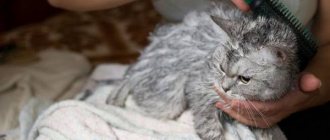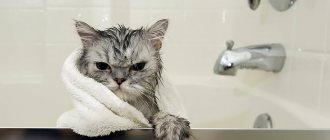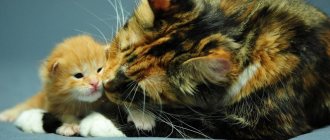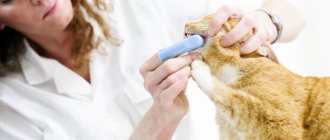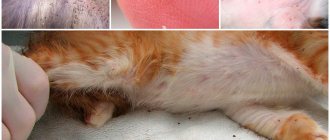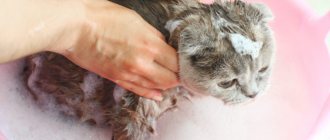What will you learn from the article?
- When is it necessary to bathe?
- At what age can you bathe a kitten?
- When can you bathe a kitten?
- How often can you bathe a cat?
- How to bathe a cat at home?
- How to bathe a cat? Industrial bathing products - popular brands
- Folk remedies for bathing
Bathing a kitten is a procedure whose feasibility can be debated. First of all, it's problematic. Secondly, it is stressful for most fluffies, who are not known for their love of water. Thirdly, cats are recognized cleanliness; they spend half their waking time washing themselves. But, there are cases when you can’t do without swimming.
Let's look in detail at what age you can bathe a cat, how to make this procedure less unpleasant, and get acquainted with the best bathing products.
When is it necessary to bathe?
Nature has endowed cats with their own hygiene complex. The rough tongue of fluffies does an excellent job of removing dirt and foreign odors from the animal’s coat; it combs the fur, increasing its thermal insulating properties.
To interfere with this natural process means to disrupt the natural protective layer of skin and fur. They bathe a cat only when the animal cannot clean itself up on its own or as part of therapeutic and preventive procedures.
Bathing is necessary:
- In case of heavy contamination: soot, oil, swamp slurry, something foul-smelling.
- If the animal is picked up from the street and it is very dirty, infested with fleas.
- Cats who returned from the street after the “sexual hunt”.
- Hairless breeds of cats - their body produces a lot of skin lubricant, which will emit an unpleasant odor if it is not washed off in time.
- Older animals and obese cats who cannot clean their fur on their own.
- Show class animals that participate in exhibitions.
- Cats with parasitic diseases (fleas), ringworm. In this case, special therapeutic and prophylactic agents are used.
- Long-haired breeds during the molting period. During shedding, more villi enter the cat's stomach - this can cause digestive problems and intestinal blockage. Bathing will wash away dead fibers - the cat will swallow less hair, and the house will be cleaner.
Important!
Remember that cats are not dogs; advice on bathing dogs should not be applied to cats.
Start time for water treatments
But bathing procedures are not always beneficial for kittens. They have their contraindications:
- Age. You should not bathe a kitten until it is three months old. During infancy, the sebum glands actively develop. Bathing can cause a malfunction of the epidermis, and the kitten will be deprived of the amount of skin lubricant it needs. This is where skin problems begin: all kinds of dermatitis and other troubles. But this does not apply to kittens that were brought from the street.
- Graft. Even a person after vaccination is not recommended to wet the injection site. For kittens, the situation is more serious. The thing is that wet fur does not retain heat, and the cat begins to feel very cold. The kitten may even catch a cold. And vaccination and disease are incompatible things.
- Disease. Here the decision is made by the veterinarian. But if there is no strict need to bathe your pet at this very moment, then it is better not to do this.
I know that bathing kittens under three months is not recommended, but I had to do this several times with a month-old baby. My cat had a particularly restless specimen in her litter. They lived in the yard; the area to be surveyed was huge. But he was drawn exclusively to the dog’s enclosure. He did this early in the morning.
At about 6-7 o'clock I found him already there, all wet and terribly dirty. The dog was glad to have company and took care of the baby, as her instincts told her - she licked it and carried it in her teeth on a tour of her property. The first time I found a kitten in this state, I was terribly scared. Having wiped it with a dry cloth, I quickly placed it under my mother’s side, hoping that she would clean it better than me.
But it was not there. She sniffed it and moved away. An hour later he was already sitting in the corner of the box, no one wanted (luckily it was hot outside). I had to bathe him in running water. After this, the cat recognized her kitten and began to take care of him again. These attacks stopped only when the kitten’s head stopped getting through the mesh of the enclosure. By the way, the baby did not suffer from frequent bathing, but he grew up too clean - he licks himself for a long time and with pleasure.
Otherwise, if the cat is purebred and participates in exhibitions, then it should be given a bath at 1 month. You should not start later, since in the future it will be much more difficult for the kitten to get used to bathing. If participation in exhibitions is expected to be deserted (= sparsely populated), then bathing can begin a little later, at the age of 3-5 months. The pet has already matured a little and such an order will be associated with less stress for him.
If there is an urgent need to bathe a month-old kitten, then the process must be approached with the utmost caution. Controlling the water temperature to prevent hypothermia is very important. You should not rush to send a kitten into the water if it has recently been revaccinated. After it you should wait at least two weeks.
At what age can you bathe a kitten?
A healthy kitten's first bath should occur no earlier than 4-5 months of age, when its baby teeth fall out.
At this age, babies experience stress from contact with water more easily, and they have already been weaned from their mother.
Bathing newborn kittens is unnecessary and harmful. Firstly, up to 1-3 months they are looked after by their mother; the cat’s rough tongue and saliva clean the kittens’ fur better than detergents. Bathing at an early age will wash away the natural postpartum lubricant that protects the baby from various infections.
Water procedures with shampoo or soap will kill the baby’s own smell - the mother cat may refuse him, stop feeding him, or even suffocate him. The third argument against early bathing is that newborn kittens have poor heat exchange, they can freeze after water procedures and catch a cold.
The only reason you might want to give your kitten a bath at an earlier age is if there is a flea infestation. Newborn kittens are not suitable for parasite treatments for adult animals. Bathing with anti-parasitic shampoo is the only possible way to treat kittens from 1 month. It is important to choose a brand of shampoo that is approved for babies.
IMPORTANT!
After vaccination, the kitten should not be bathed for at least two weeks.
10 days must pass after castration.
If you notice signs of lichen in your purr, the veterinarian has prescribed proper treatment, then he should warn that swimming with lichen is not prohibited, but is even recommended. But, since this procedure is therapeutic and is carried out with special means, we will talk about it in another article.
When can you bathe a kitten?
The allowed frequency of bathing kittens is 2-3 times a year!
Not per month, and not per week, but per year. There is no need to arrange frequent spa treatments for your kids just because the owners want it. The fur and skin of kittens are covered with a special protective layer that helps regulate heat exchange and protects against infections. Frequent bathing will disrupt this natural protective film.
A kitten cared for by a mother cat, as well as a clean kitten living at home, does not need water treatments at all. The most you can do with these babies is to wipe the soiled coat, paws or area around the anus with a damp baby wipe. There is no need to expose the baby’s vulnerable psyche to severe stress - water procedures cause a negative reaction in almost all kittens.
Of course, there are exceptions to the rules. There are kittens that show interest in water, the bathroom and shower. For example, babies of the Bengal breed, Norwegian forest cat and Maine Coon breed love to swim. There are individuals with a passion for water among other breeds.
Such pets should not be denied the pleasure of playing with a babbling stream or deprived of the opportunity to swim. The main thing is to make sure that the baby does not get too cold. Wipe it dry after bathing, dry it with a hairdryer, and keep it in a draft-free room until completely dry.
Is it possible to wash a kitten with laundry soap?
The most natural soap is considered to be laundry soap. It is valued for its good cleaning ability. But it is wrong to believe that it is suitable for bathing kittens.
Common people believe that they can wash cats with laundry soap. It’s better not to do this, but to choose a less aggressive one, with a low alkali content or a neutral PH level.
If there is no special shampoo and the kitten needs to be washed, a solution of laundry soap will do. It is suitable as an emergency measure. The cat may develop dandruff and itchy skin after a bath. Some cats experience hair loss, and allergic reactions are possible.
Laundry soap 72% from the era of socialism for a pet is a kind of poison. It is important to rinse the wool well so that the pet is not poisoned by soap components.
If you find problems after washing with laundry soap, you should immediately contact a veterinarian. He will tell you how to minimize the effects of alkaline attack on the skin.
How often can you bathe a cat?
A healthy adult cat can be bathed as often as a kitten - once every two to three months. Sick animals for whom the veterinarian has prescribed baths with special therapeutic and prophylactic agents are bathed with the frequency specified by the doctor.
If your cat is pregnant, then bathing it is highly undesirable! There is no need to expose a pregnant animal to stress - this can negatively affect its pregnancy and offspring. In case of severe contamination, wipe the cat with a damp sponge, while not forgetting to talk soothingly to the expectant mother.
If necessary, you can wash a nursing cat, and we will tell you how to do it correctly. If the animal is afraid of water, then it is better to simply gently wipe the body around the nipples with a damp cloth without using detergents! And if the cat is accustomed to water, then comfortable swimming in water at the right temperature will help the woman in labor quickly restore her appearance.
How to wash representatives of different breeds
To wash Scottish kittens, in addition to shampoo, you can also rinse with a solution of 1 tbsp. spoons of vinegar per 1 liter of plain water, this will help maintain fluffiness for a long time.
The kitten can even help)
How to wash a Persian kitten? Before bathing procedures, the wool should be degreased and thoroughly combed. After the end of the event, apply conditioner foam to it.
Wash hairless kittens once every month or two, then rub the baby with baby cream.
Wash your Maine Coon kitten like regular cats according to the rules given above. You should wash a mixed-breed kitten in the same way.
A fold-eared kitten should be washed more often, since it is a long-haired pet, because it is not able to completely clean itself. We recommend doing this at least once every 2 months.
How to bathe a cat at home?
Bathing a cat can be comfortable if you follow some rules. First, find yourself a partner. A cat is a small creature, but bathing it with four hands is more convenient. One holds the animal, and the second carries out manipulations.
Next, step-by-step instructions on how to properly bathe a cat at home .
Before you bring your pet into the bathroom, prepare everything you need.
List of what you will need:
- medium-sized shallow basin;
- a saucepan with warm water;
- ladle;
- cotton wool;
- sponge;
- brush;
- detergents;
- a set of terry towels;
- hair dryer;
- delicacy;
- rubber gloves (we reserve this item for those animals that fundamentally do not submit to the “humiliating” need to be clean by force and tear their owners’ hands to shreds with their claws);
- nail clipper
Step 1: Prudent.
Combine business with pleasure and trim your pet's nails. You remember that this needs to be done from time to time? This procedure before bathing is also intended to once again protect you from the wrath of your pet. However, there are radical methods for permanently declawing a cat, but we are not talking about extreme measures now.
Step 2. Preliminary.
Pour water into a bowl and into a saucepan. At what temperature should you bathe a cat? Considering that a cat’s body temperature is higher than that of a person, a water temperature of 30-38 degrees will be comfortable for it. But bathing in a large bathtub cannot be called comfortable for a cat, since huge expanses of water will plunge the cat into panic. A bowl of warm water is sufficient for cat procedures. Bring towels into the bathroom in advance and open bottles of detergent.
Step 3: Discreet.
Plug the animal's ears with cotton swabs to prevent water from entering. And only after that bring the cat into the bathroom.
Step 4. Extreme (as well as all subsequent steps).
How to bathe a kitten if it panics? In cold blood! Talk to him in a calm voice, showing that you are the boss of this flock and know what you are doing.
Don’t put the baby in a bowl of water right away, just wet the woolen coat as much as possible with a sponge soaked in water, trying not to scare the cat with random noise. This is why we recommended pouring water in advance.
Then you should take the detergent and rub it into the fur slowly, carefully, with massaging movements. Is it worth reminding us that we try not to get the cat’s head wet at all?
Step 5.
Use a brush to very carefully remove the resulting foam and then place the cat in the basin, pouring water from the ladle over it. If there is not enough water, then you will need an additional portion, poured into the saucepan in advance. The cat will be calmer in the basin if there is something there that he can grab onto with his claws. Some owners put the animal directly into a bowl of water, some put it in an empty basin - you can only choose your option experimentally.
The eyes and ears (outside) can be wiped with a damp hand.
Step 6.
Finally, we wrap the cat in a towel and try to hold it so that the wet animal in the wild does not become hypothermic. Rubbing with a towel is harmful to the coat, so we only blot the moisture, changing towels as needed.
Step 7
The next step is blow drying. We hold the scary and buzzing device at a distance of 30 cm from the animal’s body. Some experts convince that only long-haired cats should be blow-dried, but it seems to us that to prevent colds, it is better not to pay attention to the length of the coat, because the cat itself takes a long time to dry. If you leave a cat in a warm room after bathing, it will dry completely only after 12 hours!
Step 8
We comb out the fur with special combs and brushes, thus finally removing dead hair.
Step 9
We motivate the dried and combed cat with a treat, so that next time bathing will be associated only with pleasant moments.
How to prepare for washing
If you understand that it is necessary to wash a kitten, then it is recommended to do this with special means. At the same time, saving on shampoo can result in additional expenses for treating the consequences of such bathing. A kitten's immunity takes up to 12 months to develop, and the wrong product can cause allergies and dermatitis. Note:
- Each breed has its own coat characteristics. Washing your little Persian with Sphynx shampoo is simply not right. However, for kittens with fur there are universal options in which you can bathe any, even the fluffiest pet. In addition, the skin of small cats is softer than that of adult cats. Therefore, choose a shampoo for kittens;
- You can’t wash it with what you have on hand, soap or shampoo for people. Firstly, it is very difficult to rinse them out of thick fur, and secondly, a kitten’s skin is unlikely to withstand so many additives and flavorings;
- To replace water procedures, as well as for cases when you need to bathe a kitten quickly, there are alternative options that do not require water: dry shampoos and sprays.
The skin of a person and a cat, no matter whether it is an adult animal or a small kitten, has a completely different reaction. So any detergents intended for humans, even the mildest and most neutral baby shampoos, are completely unsuitable for a kitten.
Is it possible to wash a kitten with soap?
If a one-time emergency bath is still necessary, but there is no special “cat” shampoo on hand, you will still have to use baby soap or shampoo. Then choose not only the softest one, but also the one with the least odor. A scent that is pleasant to humans can be a real nightmare for a kitten and its relatives, since cats are very sensitive to odors. And you shouldn’t turn this into a regular practice - if possible, be sure to buy veterinary shampoo - let it be “just in case”, even if you are not going to repeat bathing in the near future.
It is best to wash a kitten found on the street with a shampoo that contains flea and tick additives. Such products are also necessary for those kittens who walk outside regularly.
For long-haired kittens, whose fur is especially difficult to wash, you can buy a special shampoo that makes combing easier. Such shampoos not only contain additives that detangle the fur, but are also easier to rinse off, otherwise you risk not completely rinsing the thick “fur coat” and getting exactly the opposite of the expected result. Unwashed wool will stick together, quickly absorb dust and look unkempt.
If the kitten has sensitive skin and after bathing it itches, dandruff, and irritation appear, you will have to change the shampoo. Sometimes you have to carry out more than one painful experiment for both the owner and the pet until you can choose the right bathing product for this particular baby.
Before bathing a kitten, you need to prepare a bath; you can remove all unnecessary items from it. The towel must be heated in advance; it is unacceptable to use cold things after taking a bath, because this can lead to illness in the pet.
You need to fill the bath with water in advance, the temperature of which should not be lower than 38 degrees. The water temperature is often checked using the elbow; if the elbow does not feel either hot or cold water, then it will be optimal for the pet. The bathroom should be preheated, free of drafts, open doors and windows.
The necessary psychological attitude is very important, not only of the baby, but also of the owner. The baby must be calmed down and encouraged with gentle words; force and sudden movements must not be used. The conversation should be gentle and calm; loud intonation will only frighten the baby even more.
It is necessary to wash the cat with confident movements, which include:
- The most important point is to place the animal in the bath; it is better to grab it by the scruff of the neck, so that it does not have the opportunity to scratch, break free and run away. Before you start washing the kitten, you need to wet its fur and keep its nose and ears dry. To avoid irritation, you should put eye drops in your pet's eyes and plug his ears with a tampon. Water should not get into the cat’s nose and ears, otherwise inflammatory processes may occur.
- It is most convenient to wash a kitten in the shower; this procedure will result in less splashing, and the animal will more easily endure such an ordeal. You can hold the cat with your left hand, and the shower with your right.
- The shower must first be put aside, and the shampoo must be applied to the back, paws and tummy of the pet, do not forget about the tail.
- Last but not least, you can wash the baby’s head, because this is the most unpleasant part of this procedure.
- A soft sponge should be used for washing.
- The easiest way to wash off the foam is with a shower from top to bottom, but you need to make sure that water does not get into the cat’s ears.
- After the pet has taken a bath, all the foam has been washed off, it must be placed in a warm towel. It is best to use two towels, and one of them must be thick, because it is unknown how the cat will behave after washing.
- You should not bathe your pet after he has eaten. The bath should be used no earlier than 4 hours after eating.
We invite you to familiarize yourself with: Names for British cats and kittens
If the kitten has survived vaccination, then it will be possible to wash it no earlier than after 2 weeks.
Naturally, the shampoo that humans use is completely unsuitable for cats. This is due to different pH values in animals and humans. An unremarkable shampoo cannot be used because it will simply ruin the animal’s hair. If the kitten accidentally gets a little dirty, you can easily wipe it with a damp cloth.
How to bathe a cat?
In pet salons, specialists use dozens of means and methods to clean up your pet, but caring for a kitten at home is simplified and one or two will be enough for you.
The first rule is that you cannot bathe your cat with shampoos for people or products for dogs - they can be dangerously toxic for your pet. Pet stores offer many special shampoos for cats - choose one that matches the type of your animal.
Shampoos for cats:
- Sprays – clean the animal’s fur and work as antistatic agents;
- Dry shampoos – powder (dry) products are suitable for cats that have not overcome hydrophobia;
- Liquid is the most common form for cats that have overcome their fear of water.
Industrial bathing products - popular brands
Manufacturers offer conventional cleansing shampoos and bathing products with targeted action: against dandruff, against allergies, against hair loss, against fleas, and lichen.
Popular brands:
- Beaphar Shampoo Hypo-allergenic – hypoallergenic shampoo.
- VEDA Phytoelite is an anti-matt shampoo for fluffy cats.
- CLINY – shampoo-conditioner.
- Beaphar Shampooing Chats & chatons – for cats and kittens.
- Bio-Groom “Klean Kitty” – spray shampoo.
- Ms Kiss “Freshness and Volume” – dry shampoo.
- Mr.Gee – dry shampoo with mint.
- Beaphar Shampoo Anti Dandruff - anti-dandruff shampoo.
- RolfClub – insecticidal shampoo.
- Beaphar Shampoo Anti-Itch – anti-itch shampoo.
